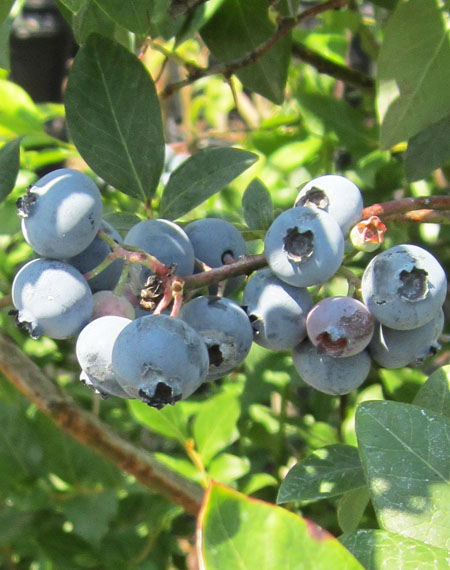Growing Blueberries

BLUEBERRIES need full sun
A. Plant in soil rich in organic matter and well draining with pH of 4.5-4.8.
This pH can be difficult to find here in Great Barrington. (In Marc Fadding’s experience with soil tests done in Southern Berkshire County, it is rare to find an acidic 5.5; rather, he has usually found a pH of 6.5 or higher.) Sulfur added to the soil is the best way to lower the pH. Preferably, amend soil long before planting (e.g. previous fall).
Ward’s offers pH test kits in aisle 4 or you can do a more thorough test through the UMass Agricultural Extension. See more about taking a soil sample and testing soil.
Once plants are established Sulfur or Ammonium Sulfate can be reapplied. Never use Aluminum Sulfate to acidify. Fertilize after establishment with Holly-Tone in the early spring and late fall.
To increase crop production apply fertilizer and or compost every spring.
Marc Fadding, President of Marconica, Inc., presented this research at Ward’s Nursery on Saturday March 12, 2017. marcf@bcn.net; Marconica, Inc. website
B. Varieties of Blueberries & Getting More Fruit
Plant at least 2 shrubs and be sure the bloom season is the same or overlapping. All varieties of High Bush blueberries only have subtle differences (in my opinion). One difference between varieties is the time of fruit ripening. Getting a mix of overlapping seasons will allow you extend your harvest period. Choose 2 early, 2 mid and 2 late-season varieties to have berries for up to 8 weeks. Choose varieties that are hardy in your temperature zone and you will do well. It is not necessary to have different varieties for cross-pollination, but it doesn’t hurt.
Chart of some Blueberry plants available and their bloom seasons to have fruit longer.
C. Provide an Arbor:
Building an arbor to support netting is the most common control for pests. When planning your Blueberry patch layout, do it with an arbor in mind. Your arbor design has to work with the dimensions of the rolls of plastic mesh (typically 7’ by 100’). And, allow for future growth of the bushes. Plastic netting should be ½” mesh; larger than that and Wrens will get in.
The design should allow the netting on the roof to be removed for the winter, otherwise heavy winter snows will rip it down and potentially destroy the arbor. You could put netting on individual bushes but I have found this to be nuisance.
D. Plan for Pests
- Birds (Robins to Turkeys) will eat all the fruit if not protected with netting.
- Chipmunks: I’ve had limited success dealing with this pest, but putting metal mesh around the bottom of the arbor and into the ground 4”and 18” high is a deterrent.
- Rabbits: Can eat the shoot tips in winter when the snow is high on the bushes. Avoid planting near thick brushy areas that harbor rabbits. Have metal fence around the bottom, up to 4’ or 5’.
- Insects and diseases: I have not encountered any worth controlling. Practice good sanitation. Remove fallen leaves and fallen dried fruit (mummy fruit).
- Weeds: Keep the root zone of your bushes weed free with annual mulching and hand weeding. Composted (aged) wood chips can be used for blueberries. The mulched area should extend beyond the bird netting if it is plastic; this will ensure that no contact is made between the netting and a weed whacker.
E. Planting
Purchase blueberries as bare-root or potted plants. For better success, potted plants are the best way to go like what’s available from Wards. The mature potted plants are readily available and inexpensive. Plant in full sun, 5’ apart in rows that are 5’ apart.
F. Lifecycle
Multi-stemmed small shrub will send up new shoots next to or from the crown. It does not send out runners. With care and regular watering/pruning, blueberries live many years.
G. Pruning
Prune during the dormant season (late winter to very early spring). Learn to identify the difference between leaf buds and flowering buds (where fruit arises from); then, you can assess each cane and decide if it’s going to produce clusters of fruit or not. Prune out these unproductive canes at the crown or ground. On very vigorous bushes, you may need to thin out some healthy wood. In this case, favor pruning out larger canes. This will induce new canes to arise. Prune out 1/3 of the plant.
Our Summer Garden Advice
By mid-summer, perennial gardens can start to look overgrown, annual flowers begin to fade, and bugs may be munching on your vegetables.
Summer Articles